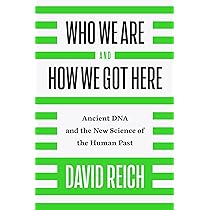David Reich’s “Who We Are and How We Got Here” audiobook explores human history through the lens of genetics. It reveals our ancestry and evolution.
David Reich, a leading geneticist, delves into the genetic makeup of ancient and modern humans. His book provides groundbreaking insights into human evolution and migration. Reich uses advanced DNA analysis to trace our origins and uncover connections between different populations.
The audiobook simplifies complex genetic concepts, making it accessible to a broader audience. It challenges previous historical narratives by presenting new genetic evidence. This work is essential for anyone interested in understanding human history and our biological roots. Reich’s research bridges the gap between genetics and anthropology, offering a fresh perspective on who we are.
Introduction To David Reich’s Work
David Reich is a leader in genetic research. He explores human history through DNA. His work helps us understand ancient human migrations. Reich’s studies reveal genetic connections across the globe. This research reshapes our view of history. It shows how interconnected we all are.
Reich has made many discoveries in genomics. He mapped ancient genomes from various regions. His work includes studying Neanderthals and Denisovans. These findings explain our genetic makeup. He uses advanced techniques to analyze DNA. His research has been groundbreaking in the field.
The Dawn Of Genomics
Scientists use DNA to trace our ancestors. They study genes to learn about human history. Our DNA tells us where we came from. It shows how people moved across the world. Ancient DNA helps solve mysteries about early humans. Researchers compare DNA from different groups. This reveals how we are all connected. DNA analysis has changed what we know about our past.
New tools make DNA study faster and easier. Sequencing machines can read DNA quickly. Computers help analyze the data. These advancements provide more accurate results. Scientists can now study older DNA samples. This includes bones and teeth from ancient times. Better technology means we learn more about our origins.
Decoding Ancient Dna
Extracting ancient DNA is a tricky process. Scientists work with very old bones or teeth. They clean the samples to avoid contamination. Next, they grind the samples into powder. This powder holds the precious DNA. They then use chemicals to pull out the DNA from the powder. The extracted DNA is often damaged and fragmented. Special techniques help to piece it back together. This process reveals the genetic secrets of the past.
Working with ancient DNA has many challenges. The DNA is often damaged by time. It can also be mixed with modern DNA. Scientists have developed new methods to filter out contaminants. They also use advanced technology to read even the smallest DNA fragments. These breakthroughs help us understand our ancient ancestors better. They reveal how humans have migrated and evolved over time.

Migration And Population Structure
Genetic data reveals ancient human migrations. Indo-European migrations played a key role. They spread languages and cultures. These migrations reshaped Europe and Asia.
Neolithic farmers migrated from the Near East. They brought farming to Europe. This changed the region’s way of life. Genetic data shows their interactions with local hunter-gatherers.
Case studies highlight these movements. They show how populations mixed and evolved. Genetic data helps us understand our ancestors. It reveals how they adapted and survived.
The story of human migration is complex. Each wave of migration left a mark. Our genes carry the history of these movements.
The Impact Of Neanderthal Dna
Neanderthals and modern humans interbred thousands of years ago. This left a genetic legacy in our DNA. Up to 2% of the DNA in non-African humans is from Neanderthals. These interbreeding events happened in Europe and Asia.
Neanderthal DNA affects our immune system and skin. Some of these genes help fight off diseases. Other genes may cause allergies or other conditions. Understanding this legacy helps us learn about human evolution.

Disease, Genetics, And Ancient Dna
Ancient DNA helps us understand the roots of modern diseases. By studying ancient bones, scientists discover genetic mutations. These mutations can cause or resist diseases. Some genes make people more likely to get sick. Others help them stay healthy. Ancient DNA shows us how diseases spread. It tells us where certain diseases came from. This knowledge helps doctors today.
Some people have genes that protect them from diseases. These genes offer genetic resistance. Other people have genes that make them more likely to get sick. This is genetic susceptibility. Understanding these genes helps in developing better treatments. It also aids in creating vaccines. Ancient DNA shows how these genes evolved over time.
Ethical Considerations In Genetic Research
Genetic data is very personal. Sharing this data can be risky. Hackers could steal genetic information. This could lead to identity theft. People worry about their privacy. They fear misuse of their data. Keeping genetic data safe is crucial. Scientists must respect privacy.
Genetic manipulation can change genes. This can cure diseases. But, it can also be misused. Some people worry about “designer babies”. They fear creating perfect humans. This raises ethical questions. Is it right to alter human genes? The debate continues among scientists and the public.
The Future Of Genomics
Predictive modeling uses genomic data to foresee health risks. This helps in creating personalized medicine. Each person gets a unique treatment plan. Doctors can better understand diseases and conditions.
Genetic tests reveal predispositions to illnesses. This allows for early intervention. People can make lifestyle changes to avoid problems. Personalized medicine means fewer side effects. Treatments are tailored to each individual.
Scientists explore ways to enhance human abilities. Genomics plays a crucial role. They study how genes affect strength and intelligence. The goal is to improve quality of life.
Ethical questions arise with human enhancement. Society must decide on acceptable limits. The potential for inequality is significant. We must balance benefits and risks carefully.

Conclusion
David Reich’s “Who We Are and How We Got Here” audiobook offers profound insights into human history. This captivating listen combines science and storytelling, making complex topics accessible. Perfect for anyone curious about our origins, this audiobook is a must-have.
Dive into the journey of human evolution with Reich’s expert narration.



